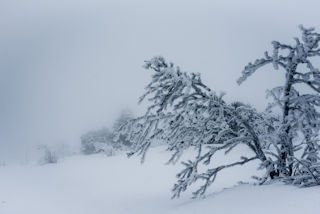Extreme Cold Cloze
What do your children know about extreme cold weather conditions? Test them with this fun cloze worksheet.
&npsp;
In winter months, snow and ice can look pretty and be great fun to play around in, but freezing conditions can be very dangerous. Here we look at some of the vocabulary and implications of extreme cold.

Hailstorms occur when water droplets freeze in the atmosphere, and fall to the ground. These balls of ice can measure between 5–200 mm. The largest hailstones often fall during a severe thunderstorm. Snow forms higher in the atmosphere where temperatures of less than 0ºC (32ºF) cause water vapour to turn straight to ice crystals. When these gather together they get heavier and fall as snowflakes. Heavy snowfall is known as a ‘snowstorm’, and strong winds of 35 mph (46 kph) or more turn them into a ‘blizzard’. In blizzard conditions, it can be very difficult to see in front of you, making driving extremely dangerous!
If someone is caught in a blizzard without adequate protection they can also experience frostbite (frozen skin and body tissue) or hypothermia (low body temperature). The ‘wind chill’ can make you feel much colder, too. This is because your body loses more heat the faster the wind is blowing.
Heavy snowfall can also bring the risk of an avalanche – a moving mass of snow that may also contain ice, rocks and uprooted trees. When a large section of snow becomes unstable and begins to move downhill, it can grow in size and pick up speed rapidly. Avalanches have been known to reach 245 mph (394 kph) – about three times the speed of a downhill skier.
In 1947 and 1963, the UK experienced some of the coldest winters on record. Exceptional snowfall caused snowdrifts up to seven metres deep and thousands of people were stuck in their homes and villages. The army was needed to clear roads and railways and many villages had supplies flown in by helicopter. When the warmer weather eventually came in 1947, the melted snow caused rivers to burst their banks flooding surrounding areas, while in 1963, temperatures below –20ºC (-4ºF) caused rivers to freeze and blocks of ice were found in the sea.
What do your children know about extreme cold weather conditions? Test them with this fun cloze worksheet.
Can the children imagine they are living through a period of extremely cold weather, and describe the experience in this diary?
Find out some facts about extreme cold weather with the help of our handy factsheet.
The newspapers here in the UK often write stories about the weather! Our newspaper prompts let the kids write their own reports on weather events- this one is all about extreme cold.
It looks a bit chilly in this photo, doesn't it? There is deep snow and possibly blizzard conditions, making it a perfect photo to illustrate "Extreme Cold" as part of our "Extreme Weather" series.
This macro photographic shot of snowflakes is perfect for an extreme weather discussion, or a snowflake topic. Snowflakes are beautiful indeed!
Safety leaflets are often handed out to warn people about the dangers of extreme weather and to give advice on how to stay safe. Can the kids create their own leaflet containing helpful advice on extremely cold weather?
What do people need to do to stay safe in extremely cold weather? Ask the children to find out the potential dangers, then design a poster warning people and offering advice on how to stay safe and warm.
Use this extreme cold story paper for weather reports or to spark off some creative writing.